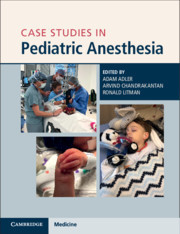Description
Case Studies in Pediatric Anesthesia
Coordinators: Adler Adam C., Chandrakantan Arvind, Litman Ronald S.
Covers the most important and relevant topics on the anesthetic care of children, using a question-and-answer format.
Language: English
Subject for Case Studies in Pediatric Anesthesia:
Publication date: 12-2019
530 p. · 19x24.7 cm · Paperback
530 p. · 19x24.7 cm · Paperback
Description
/li>Contents
/li>Biography
/li>
Pediatric anesthesiologists will encounter numerous challenges when caring for children, as their work involves more than simply adjusting drug dosages and equipment for smaller patients. In response, this practical book provides clinical guidance in an easily accessible and digestible question-answer format. Case Studies in Pediatric Anesthesia reviews the entire breadth of pediatric anesthesia and pain management, taking a case-based approach. Each chapter commences with a clinical case or scenario, guiding the reader through a tailored discussion. The chapters review the pathophysiology, anesthetic techniques, and surgical and perioperative considerations. High quality tables and figures feature throughout to help solidify key concepts. The chapters are prepared to be read in isolation and for reference when appropriate. Case Studies in Pediatric Anesthesia is aimed at anesthesiologists of all levels, from the trainee on their first pediatric rotation, to the pediatric fellow preparing for boards examination to the seasoned clinician.
Foreword; List of contributors; 1. Normal parameters for paediatric anesthesia; 2. Pharmacology and physiology in the term neonate; 3. Anesthetic neurotoxicity in children; 4. Preoperative anxiety; 5. Postoperative nausea and vomiting in children; 6. Emergence delirium; 7. Anesthesia care for the premature infant; 8. Monitoring of the pediatric patient; 9. Blood and transfusion; 10. Asthma; 11. Sepsis; 12. Malignant hypothermia; 13. Cystic fibrosis; 14. Muscular dystrophy; 15. Spinal muscular atrophy; 16. Burns management; 17. Pediatric trauma; 18. Infant hernia repair and prevention of postoperative apnea; 19. Anterior mediastinal masses; 20. Esophageal atresia and tracheoesophageal fistula; 21. Phyloric stenosis; 22. Congenital diaphragmatic hernia; 23. Thoracic surgery in children; 24. Abdominal masses: neuroblastoma; 25. Abdominal masses: wilms tumor; 26. Congenital hyperinsulinism and pancreatectomy; 27. Hepatic poroenterosomy: kasai procedure; 28. Liver transplantation; 29. Renal transplantation; 30. Myringotomy and ear tube placement/upper respiratory infection; 31. Adenotonsillectomy; 32. Tracheobronchial foreign body; 33. Laryngotracheal reconstruction surgery; 34. Thyroid surgery; 35. Myelomeningocele and hydrocephalus; 36. Pediatric neurological tumors; 37. Epilepsy surgery; 38. MoyaMoya disease; 39. Cleft lip and palate; 40. Craniosynostosis; 41. Anesthesia for dental procedures; 42. Strabismus surgery; 43. Anesthesia for penile procedures; 44. Bladder exstrophy; 45. Anesthesia for ex utero intrapartum therapy (EXIT); 46. Midgestational fetal procedures: prenatal repair of an open neural tube defect; 47. Scoliosis surgery; 48. Pectus excavatum: the nuss procedure; 49. Vertical expandable prosethetic titanium rib insertion; 50. Pediatric epidural anesthesia; 51. Upper extremity nerve blocks; 52. Lower extremity nerve blocks; 53. Truncal blocks; 54. Local anesthetic systemic toxicity (LAST); 55. Acute postoperative pain management; 56. Chronic pediatric pain; 57. Distraction techniques for pediatric pain management; 58. Transitional circulation; 59. Patent ductus arteriosus; 60. Coarctation of the aorta; 61. Atrial septal defects; 62. Ventricular septal defects; 63. Anesthesia for cardiac catheterization; 64. Tetraology of fallot; 65. Transposition of the great arteries; 66. Anomalous pulmonary venous return; 67. Truncus arteriosus; 68. Pulmonary hypertension in children; 69. The fontan patient; 70. Ventricular assist devices; 71. Noncardiac surgery in a glenn patient; Index.
Adam C. Adler, is a physician at Texas Children's Hospital and Baylor College of Medicine specializing in pediatric general and cardiovascular anesthesiology. Dr Adler is a clinical researcher having authored numerous peer reviewed publications in addition to a variety of invited speaking engagements. He has received the prestigious appointment as a Fellow of the American Society of Echocardiography with a focus on education and research surrounding the perioperative use of point of care ultrasound.
Arvind Chandrakantan is an Assistant Professor of Anesthesiology and Pediatrics at Baylor College of Medicine, Texas Children's Hospital in Houston, Texas. Arvind is a physician scientist whose work centers around the neurocognitive phenotype and mechanisms of pediatric obstructive sleep apnea. He does both clinical and basic science research in pediatric OSA and is the PI in several ongoing studies of the disorder.
Ronald S. Litman is an Attending Anesthesiologist in the Department of Anesthesiology and Critical Care at The Children's Hospital of Philadelphia and Professor of Anesthesiology and Pediatrics, Perelman School of Medicine at the University of Pennsylvania. Dr Litman is a widely sought-after speaker, and the author of hundreds of published articles, abstracts, and several books, most notably Basics of Pediatric Anesthesia (2016), which is used in training programs worldwide. Dr Litman is the medical director of the MHAUS hotline, and the medical director of the Institute for Safe Medication Practices. He is a member of the FDA's Anesthesia and Analgesia Drug Products Advisory Committee and received a Masters in Law at the University of Pennsylvania School of Law.
Arvind Chandrakantan is an Assistant Professor of Anesthesiology and Pediatrics at Baylor College of Medicine, Texas Children's Hospital in Houston, Texas. Arvind is a physician scientist whose work centers around the neurocognitive phenotype and mechanisms of pediatric obstructive sleep apnea. He does both clinical and basic science research in pediatric OSA and is the PI in several ongoing studies of the disorder.
Ronald S. Litman is an Attending Anesthesiologist in the Department of Anesthesiology and Critical Care at The Children's Hospital of Philadelphia and Professor of Anesthesiology and Pediatrics, Perelman School of Medicine at the University of Pennsylvania. Dr Litman is a widely sought-after speaker, and the author of hundreds of published articles, abstracts, and several books, most notably Basics of Pediatric Anesthesia (2016), which is used in training programs worldwide. Dr Litman is the medical director of the MHAUS hotline, and the medical director of the Institute for Safe Medication Practices. He is a member of the FDA's Anesthesia and Analgesia Drug Products Advisory Committee and received a Masters in Law at the University of Pennsylvania School of Law.
© 2024 LAVOISIER S.A.S.




